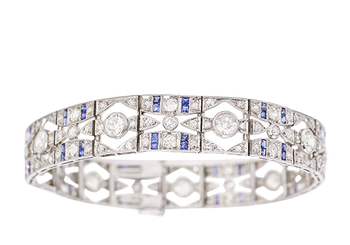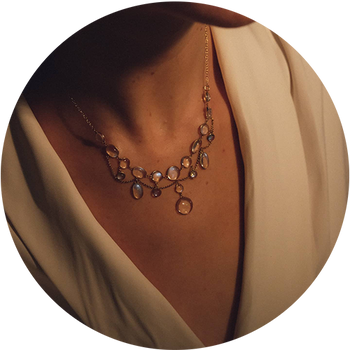Victorian Diamond Prince of Wales's Feathers Bangle
Victorian Diamond Prince of Wales's Feathers Bangle
$1,100.00
Description
DATE: Victorian, c.1900
Prince of Wales's Feathers is a heraldic emblem of (you guessed it) the Prince of Wales - the title traditionally given to the heir to the British throne, currently Prince Charles. The badge comprises three ostrich feathers emerging from a gold coronet (crown), sometimes with the words Ich Dien (I serve) on a ribbon beneath. Its origins trace back to Edward, the Black Prince (1330-1376), who was eldest son and heir apparent to Edward III. Edward III chose three ostrich feathers as an alternative to his royal arms, described as his "shield for peace". The feathers first appear at the wedding of Edward III to Philippa of Hainault, so it's likely that the Black Prince inherited the crest from his mother's side - the Counts of Hainault traditionally gave the eldest sons the title "Count of Ostrevent", the ostrich feathers presumably forming an heraldic pun on that name.
A popular folk legend posits an alternative, and far more entertaining, narrative to the question of where the three feathers originated, however. It is said that the blind King John of Bohemia, with whom the Black Prince fought and ultimately defeated and killed at the battle of Crécy, originally bore the three ostrich feathers as his heraldic arms, along with the motto Ich Dien. After the battle (1346) the Black Prince went to the body of the dead king at took his helmet with its ostrich feather crest, incorporating the latter into his own heraldic arms. Incidentally, the motto is a near homophone for the Welsh "Eich Dyn", meaning "your man", which further embellished the tale, as it would have presumably helped endear further the young Edward to the Welsh soldiers.
Another good, and equally lacking in any historical evidence, story relates to the Welsh archers who fought at Crécy. They were formidable to say the least, and at the time were considered the best in the world (particularly those from Monmouth, but that's another story). The French so feared their accuracy that they would cut off the first two fingers of any they captured, thus rendering them unable to draw a bow, before releasing them back to the English camps (holding prisoners was costly and time consuming, so they typically let them go asap). After the English victory at the Battle of Agincourt (1415), the Welsh archers are said to have gathered on a mound above the French prisoners and waved their first two fingers as a gesture of defiance and, of course, a warning. The gesture's meaning hasn't changed so much over the centuries...
The feather and coronet emblem as we know it today is also used to symbolise the Welsh nation, particularly army regiments and in Welsh rugby union. This bangle features a diamond-set version of the feathers and coronet in silver, mounted on an adjustable gold wire bracelet. It dates from the turn of the 20th century, when the incumbent heir to the throne was Prince Albert Edward (Edward VII).
STONES
Old mine and rose cut diamonds
MEASUREMENTS
Maximum inner circumference: 7 3/4 inches
Head: 1.7 x 1.5cm
Width of band: 1.3mm
WEIGHT
5.9g
MARKS
No marks present, tests as 9k gold and silver
CONDITION
Very good, light wear commensurate with age







































Follow Us
Dealing Podcast blog instagram TikTok facebook